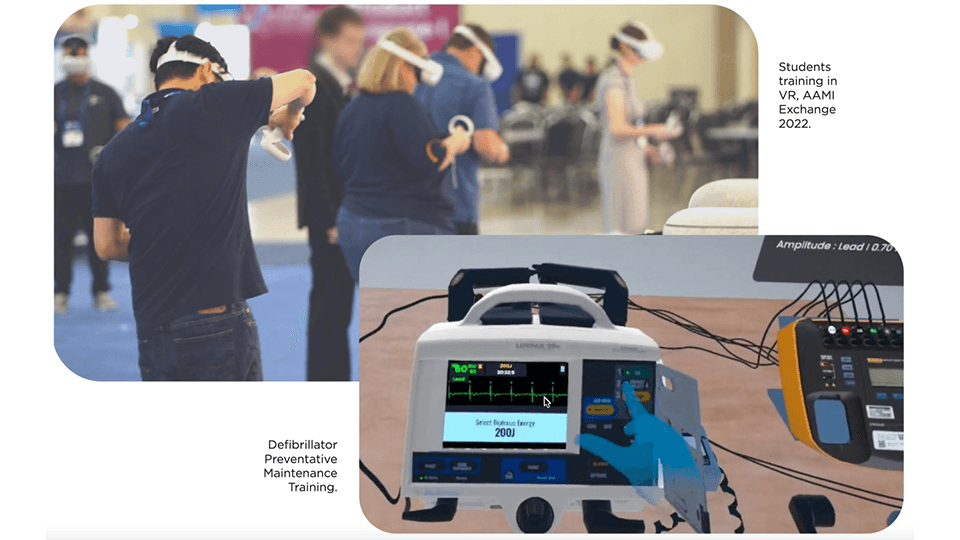
Could VR Revolutionize HTM Training?
Published over 2 years ago.
Our industry is constantly evolving. It goes without saying that medical device service is a fast-paced and dynamic field full of both challenges and opportunities. With much of the industry struggling with limited resources and an aging workforce, there’s an abundance of knowledge and skill gaps that desperately need to be filled. With that being the case, as an industry we are always on the lookout for new strategies to give us an edge. Whether it’s GPS device tracking platforms, new workflow automation apps, or a number of new AI productivity tools, our techs in our industry are fairly good at adopting new technologies—as long as they promise to help us manage our workloads. So, what’s the next wave? Could the next technology that is showing great promise be extended reality? We feel that with its immersive and interactive nature, VR has the potential to completely revolutionize and democratize the way BMETs, and all healthcare professionals, are trained. Let’s explore the potential of VR and XR technologies in the biomedical equipment industry and how they can improve the quality of training, support, and patient care.
Is Virtual Reality actually good for training real-world skills?
Let’s start with a 30,000 foot view. Virtual reality (VR) training and emerging technologies have been making a significant impact on various industries. With VR success stories coming out of everything from welding, automotive, to clinical training programs, the data is showing that virtual scenarios significantly increase both speed to competency and retention. And according to a study coming out of UCLA, VR simulations drastically improve performance of surgeons. In the study 20 surgeons were to perform a procedure to repair a fractured tibia. The results showed that the surgeons who simulated the procedure in VR before the real procedure were 6 times less likely to make a mistake during the procedure and they completed the procedure an average of 20% faster.
The biomedical equipment technician sector is no exception to the rule. We are already seeing adoption of these technologies provide a more engaging learning experience compared to traditional training methods. At the AAMI Exchange in June 2022, nine BMET students (no prior experience) participated in a proof-of-concept virtual reality training on a contrast injector PM procedure. The training was put on by the Imaging Academy and Maull Biomedical. After spending 20-30 minutes in a virtual simulation, all nine students were able to successfully perform a full PM procedure on a live device in under 2 hours.
Essentially, VR improves performance by providing a more immersive and interactive training experience for medical device technicians, making it easier for learners to understand and manage complex medical equipment faster. By keeping learners interested and invested in the training process, VR and XR can lead to better retention of information and better performance in the field. Most of us agree that in this industry, the best way to learn is by doing. VR training provides that opportunity anytime, anywhere.
What advantages does VR have over traditional training?
One of the main benefits of VR training is simply that it provides a realistic and safe environment for technicians to learn how to service and manage medical devices. VR simulations can simulate a variety of scenarios and medical equipment malfunctions, which can help technicians become more prepared for real-life situations. By using VR technology, BMET’s can practice their skills and troubleshoot potential issues without the risk of damaging real medical equipment or putting patients at risk.
VR technology can also help reduce training costs for medical device service and management companies. Traditional training methods can be costly, as they require travel expenses, equipment logistics, and instructor fees. However, VR training can be accessed remotely, which can reduce travel expenses and eliminate the need for physical training equipment. Additionally, once the VR simulations have been created, they can be reused indefinitely.

What other technologies are showing promise for training and beyond?
Emerging technologies such as augmented reality (AR) and mixed reality (MR) can also provide valuable benefits to medical device service and management companies. AR technology can overlay digital information onto real-world objects, which can help technicians identify and troubleshoot problems in real-time. AR technology can be used to provide step-by-step instructions for equipment maintenance or repair. MR technology can combine the benefits of VR and AR, allowing technicians to interact with virtual objects in the real world. This can be particularly useful for complex medical equipment that requires a high level of precision and accuracy. We believe that while VR shines for initial controlled environment training, AR and MR really show a strong utility in the real-time field repair applications.
In conclusion, we at NVRT Labs, believe that VR/XR training and emerging technologies have the potential to become the next technology megatrend in our industry. It may only be a matter of time before every device sold has an accompanying XR training module. It could be a very good thing for the whole industry if one day there’s an XR headset in every biomed toolbox in the country.
Author: Matthew Bassuk, CEO, NVRT Labs
Matthew is the founder of NVRT Labs, an XR training tech company that works with Health Systems, ISOs, and educational institutions to develop VR and AR training solutions for HTMs.
View original in TechNation here: https://1technation.com/technation-magazine-june-2023/
